Now more than ever, it is important to make sure each stall on your dairy is occupied by the most profitable cows. One way to improve profit per stall is to change the makeup of your herd and milk a higher percentage of older cows, as they are typically the best producers.
This graph (Figure 1) reflects a typical trend for dairies I work with and shows the improvements in production by lactation. In this example, the difference in production from first- to second-lactation animals is significant (over 5,500 pounds) and adds up quickly. Albeit a bit optimistic right now, at $16 milk, these additional pounds can add nearly $900 more in revenue per cow.
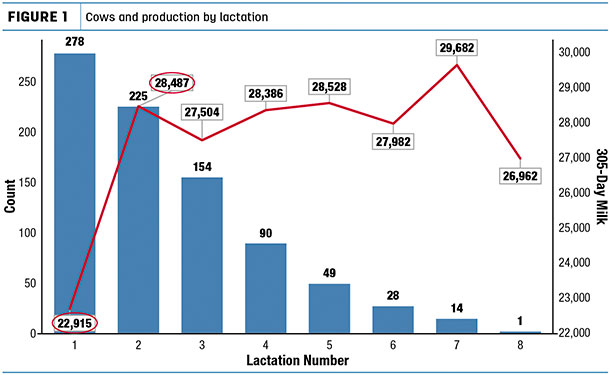
While every herd must have some first-lactation animals to replace nonproductive older cows, keeping that percentage around 30 to 32 percent helps minimize the drag. Breeding every cow to a dairy bull and milking every resulting heifer generally goes against this idea. Breeding a portion of your herd to beef can help keep the percentage of first-lactation cows in check and maximizes revenue and profit from the total calves born on a dairy, regardless of herd size.
Along with greater milk production and reduced herd turnover, you can reduce the number of heifers you need to raise and feed as replacements. As feed costs for replacement animals are typically one-fourth of the total feed bill of a dairy, removing some of this expense can certainly help your bottom line.
With today’s good reproduction and great calf-raising skills, a dairy can easily produce sufficient replacements without using sexed semen on heifers. However, you should consider using sexed semen on the best genetics to create the pool of first-lactation animals you will need. Selective use of sexed semen allows you to decide how many replacements best fit your future plans and housing situation.
Using a herd replacement calculator, let’s review a few examples of how much beef semen and sexed semen is needed for this strategy.
How many replacements?
Example 1
Goal: Your herd has a 40 percent cull rate and would like to generate 20 percent more heifers than needed. This allows you to expand a little if you decide to, or if you have a lucrative market for dairy sales and can capitalize on that.
Plan: The following plan generates 121 percent of the replacements needed. It requires 100 percent sexed semen on heifers for first service, followed by conventional semen. For cows, conventional semen is used for all services in first lactation, first and second service in second lactation and first service only for third and greater lactations. All other cow services are bred to beef.
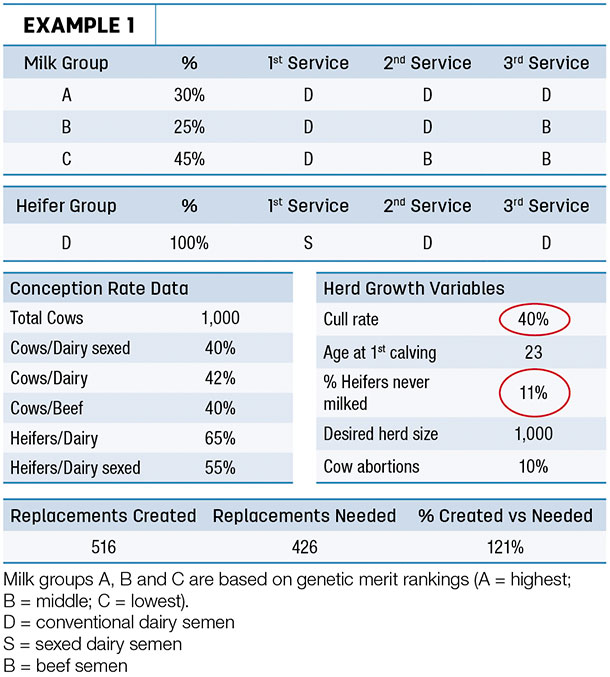
Example 2
Goal: Your herd only wants to raise the number of heifers needed as replacements and you have a very low cull rate. You want to target sexed semen on your very best cattle in order to get heifer calves from them. You do not want to worry about finding a dairy market for excess animals and believe in not overcrowding. You are most comfortable with a 5 percent cushion in case of any unforeseen disasters.
Plan: This plan creates 104 percent of the replacements needed. Since you have a very low cull rate and great heifer survival, it takes a lot less heifers to fill your needs.
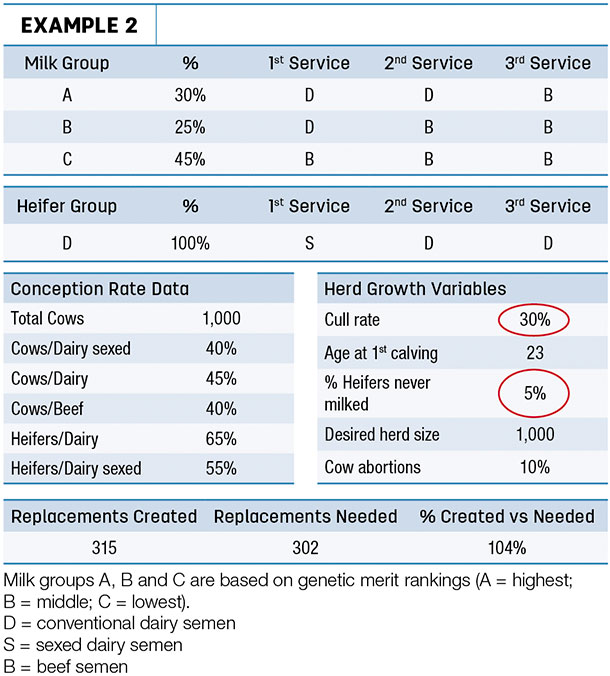
Considerations: Notice how cull rate, age at first calving, heifer survival, conception rates and abortion rate all have a big effect on replacements needed.
Both examples are for the same size herd. Notice the higher percentage of beef services that are required to maintain herd size in example two, compared to example one.
Clearly, there are many scenarios that could work to achieve either goal; these are just a few to cause you to think further about how to change the makeup of your herd.
Which animals to breed with dairy, sexed dairy or beef semen?
Knowing your herd’s goals for replacements and growth is the first step and allows you to determine the percent of your herd that needs to be bred to beef.
The next step is to develop your breeding list, identifying which animals get bred to conventional or sexed dairy semen, or beef semen. In this process, the more data you have to make a decision, the better your decision can be. This is a great time to utilize your DHI information to help determine which genetics are best to build your future herd, as well as which genetics are logical beef-on-dairy breedings.
You are probably wondering what information to consider to get started. Genomic test results and data from DHI records, including actual milk production and parent averages for NM$, are all good factors from which to start. From my point of view, the best choices use a combination of genetic ranking and actual performance.
In this example, I used a combination of NM$ and herd ranking for energy-corrected milk (ECM). Rankings for ECM are A, B, C, D and E. A is the best ranking, and E represents the poorest performers in your herd. In this example, let’s first focus on cows ranked D and E for ECM, with a NM$ of less than or equal to $200. Note that the NM$ can be from genomic test results or parent average.
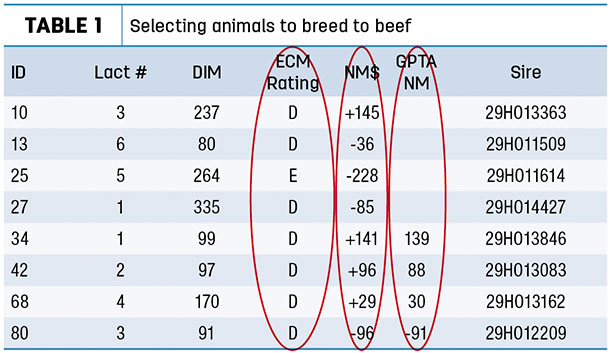
Using the requirements described, we get a report like this that shows your poorest performers. Of course using criteria similar to this requires you to continuously move up the NM$ and ECM thresholds until you have enough animals to breed to beef. For example, the next step in a selection process like this could be to increase NM$ to less than or equal to $300 with a ECM ranking of C, D or E. If your herd is using a mating program, work with your genetic consultant to help determine the selection process, and they can incorporate beef semen usage into your mating plan.
Which beef breed to use?
The next question to consider is which beef cross to use. To answer that, you need to know what you intend to do with the crosses. Are you going to feed them until marketing as steers, or will you sell them as baby calves? Time, cash flow, feed and space should all factor into your decision, resulting in the highest premium possible.
If you plan to finish your crossbreds, choose beef sires that optimize feed efficiency, growth and carcass merit. The Angus and SimAngus breeds can be good choices. This table highlights a few examples of terminal crosses.
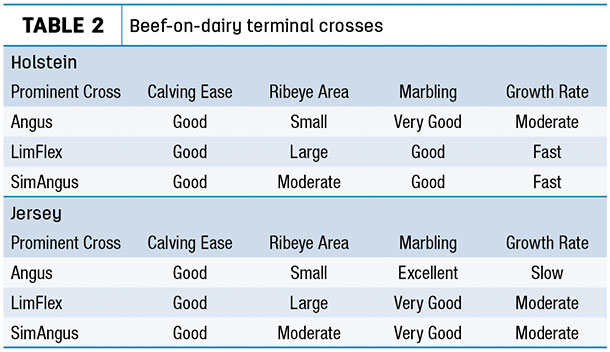
Crosses sold as babies that are black hided demand a 50 percent premium in the current market. Because of that, most producers are using Angus for calving ease and the polled aspect.
Limousin and Lim-Flex bulls offer added bone and muscle to their offspring, but are not truly calving ease. Because of that, they can be good choices for Jersey cows, but may need to be avoided on heifers. Keep in mind that hybrid vigor will cause additional growth at birth, weaning and yearling stages. Another option if you are retaining calves only through weaning is to use higher growth bulls such as a Simmental or an elite Angus.
Minimizing calving difficulties should remain a high priority. Just because you use beef semen does not mean the bull is calving ease. When using beef semen on dairy heifers, use sires with known calving ease and birthweight information.
As a rule of thumb, select sires that rank in the top 50 percent of the breed for calving ease. For larger framed breeds such as Limousin, you may want to adjust that to use only the bulls that rank in the top 30 percent.
When you have a plan and use the beef breed that best fits your goals, adding beef-on-dairy to your breeding program adds value to bull calves and non-replacement heifers. Dairy crossbreds compete favorably with native beef in terms of marbling score and quality grade. Improvements in growth rate and muscle size and shape are additional benefits from using beef bulls on dairy animals.
This was originally printed in the NorthStar News July/August 2018 issue.





